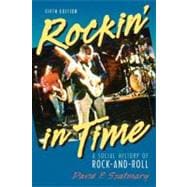
Note: Supplemental materials are not guaranteed with Rental or Used book purchases.
Purchase Benefits
| The Blues, Rock-and-Roll, and Racism | |
| Elvis and Rockabilly | |
| Dick Clark, Don Kirshner, and the Teen Market | |
| Surfboards and Hot Rods: California, Here We Come | |
| Bob Dylan and the New Frontier | |
| The British Invasion of America | |
| Motown: The Sound of Integration | |
| Acid Rock | |
| Fire From the Streets | |
| Militant Blues on Campus | |
| Soft Sounds of the Seventies | |
| The Era of Excess | |
| Punk Rock and the New Generation | |
| I Want My MTV | |
| The Promise of Rock-and-Roll | |
| The Generation X Blues | |
| The Rave Revolution | |
| The Many Faces of Hip Hop | |
| Metal Gumbo: Rockin' in the 21st Century | |
| Bibliography | |
| Index | |
| Table of Contents provided by Publisher. All Rights Reserved. |
The New copy of this book will include any supplemental materials advertised. Please check the title of the book to determine if it should include any access cards, study guides, lab manuals, CDs, etc.
The Used, Rental and eBook copies of this book are not guaranteed to include any supplemental materials. Typically, only the book itself is included. This is true even if the title states it includes any access cards, study guides, lab manuals, CDs, etc.